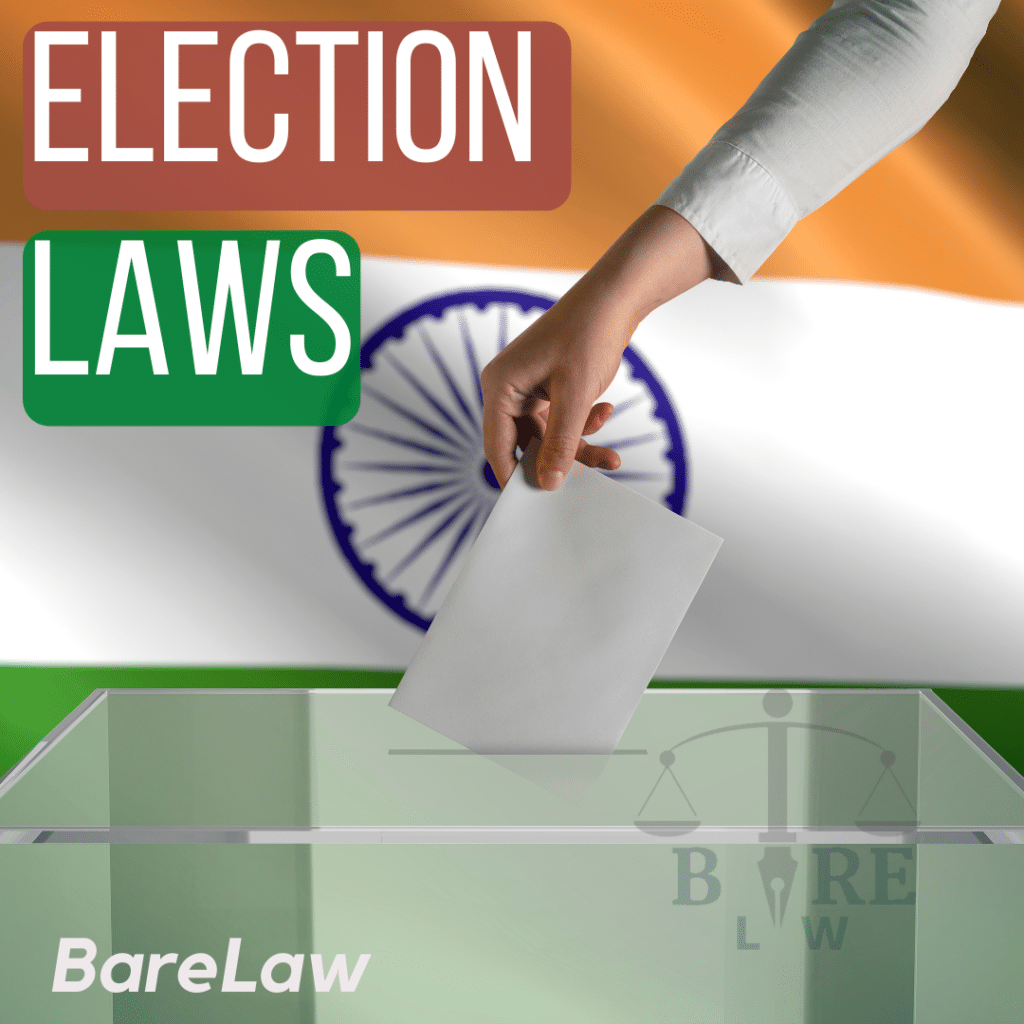
Table of Contents
ELECTION LAWS
Authored By: Harpreet Kaur
What are the election laws in India?
India has a set of rules and regulations that govern the conduct of elections. Although elections at the central government level are different from those in the state governments, parliamentary and legislative assembly elections are largely governed by similar rules. These are:
- Presidential and Vice-Presidential Elections Act 1952: This law is specific to electing for the Indian President and Vice-President.
- Presidential and Vice-Presidential Elections Rules 1974: These rules provide for an elaborate administration of Presidential and Vice-Presidential Elections Act 1952.
- Representation of the People Act 1950: It mainly deals with preparation, revision, etc .of electoral rolls.
- Registration of Electors Rules 1960: These rules include overseeing changes to and updating electoral rolls as well as registering and verifying details about voters. They also specify how eligible electors may be registered, voter identification cards issued. They govern inclusion/exclusion/correction-related matters concerning an ID card.
- The Representation of the People Act (RPA) 1951 addresses issues such as disputes after an election or malpractices. All these disputes should be raised before State High Court for respective constituency.
- The R.P.A., (1951), on post-election concerns like disputes as well as acts of malpractice; all such disagreements must be put forth in front of State High Court for relevant constituency.
- The Representation of People’s Acts (RPAs) [1951], concentrates on dealing with issues arising out of elections like disputes, frauds among others; any dispute must be referred to State High Court for that current electoral area.
- Conduct of Elections Rules (1961) contain detailed regulations laid down by Central Government and Election Commission. Formulated under Section 169 of this Act these laws regulate various aspects pertaining to election process at all levels right from issuing written notifications regarding elections registering nominations candidate withdrawals endorsements review conducting polls counting votes. Further, the legislation determines the composition of houses on the basis of electoral results.
Structure of the Indian Democracy
Democracy is one of the fundamental inalienable features of the Indian Constitution and is part of the constitutional framework. The concept of democracy as expressed in the Constitution presupposes a method of election to represent the people in Congress and state legislatures.
Democracy can only prosper if there is respect for rule of law, and there should be appropriate individuals who are elected to represent people in order to have a well-run country. In order to choose the best possible candidates as representatives for people free and fair elections must be held where voters can exercise their right freely. It is therefore imperative that free and fair elections constitute the bedrock of Indian democracy.
India is the world’s largest democracy. With 28 states and eight union territories, India holds more elections than any other country in the world. In the 2019 parliamentary elections, 911 million people were eligible to vote. This major election was conducted over 40 days and divided into 11 stages.
Three Major Types of Elections in India
General Elections – General elections are used to form the National Assembly and elect members of Parliament for all 543 parliamentary constituencies in India.
General Elections – Legislative Assembly elections (state elections) are held every five years in India, where voters in India elect members of the Vidhan Sabha and members of the Vidhan Sabha are elected to the state (or Legislative Assembly/ elect the prime minister of the state legislature. .
By-election – During a general election, by-elections also known as by-polls are held to fill an elected post that becomes vacant.
Structure of the Election Commission of India
It consists of one election management committee chairperson and two election management committee members. The Chief Election Officer and Election Commissioner are appointed by the President. The term of office is 6 years or until the age of 65, whichever comes first. They enjoy the same rank as judges of the Supreme Court of India and receive similar salaries and benefits. The chief electoral officer can only be suspended through parliamentaryimpeachment proceedings.
At the state level, election affairs shall be supervised by the state’s chief elections officer. This Chief Electoral Officer shall be appointed by the Commission from among senior officials recommended by the State Government concerned and shall be subject to the overall supervision, direction and control of the Election Commission. Committee. In most states, he is a full-time police officer with a small staff support team.
The huge task force that conducts national parliamentary elections is made up of approximately 5 million election officials and plainclothes police officers. The giant voting machines are under the authority of the Election Commission, which will monitor and supervise them during the one-and-a-half to two-month election cycle.
Overview of the Election Commission of India
The Constitution sets up a permanent institution called ‘the Election Commission’. On January 25th,1950,the Constitution established an Election Commission.In2001,it celebrated its Golden Jubilee.The Election Commission is an autonomous legal body established for conducting federal as well as state-level elections in India. Its functions include administration of elections to the parliament of India, state legislatures and offices of President and Vice-President.
Representation of the People Act, 1950
- Articles 81 and 170 of the Constitution of India provide for the provisions of Parliament and the Legislative Assemblies of the States. It establishes the maximum number of seats in the State House of Peoples and State Assemblies, as well as certain principles to be followed in the distribution of seats. However, the state legislature leaves the actual allocation of these seats up to Congress.
- Similarly, Article 1 of the Constitution of India prescribes the maximum and minimum number of seats in the Legislative Council of a state and also prescribes various ways in which the seats may be filled, although the actual number of seats filled is It is a matter for the law to decide. Decide on the method for each seat.
In summary, this law provides the following provisions in relation to elections:
1. Distribution of seats in the House of Peoples, State Legislative Assemblies and State Legislative Assemblies.
2. State, Congressional and Congressional district boundaries
3. Election officials such as returning officers, district returning officers, and voter registration officers
4. Voter rolls for state assemblies, parliamentary and parliamentary constituencies
5. How seats in state councils are filled by representatives of union territories.
6. Local government for the purpose of elections to the State Legislative Council.
7. Exclusion of Civil Court Jurisdiction.





